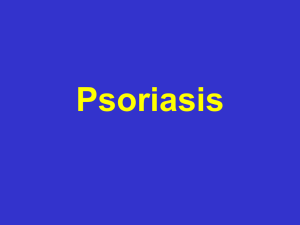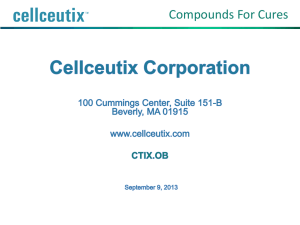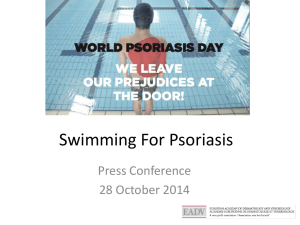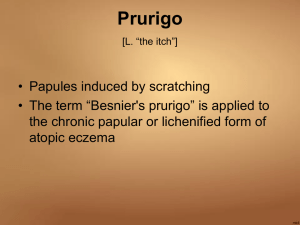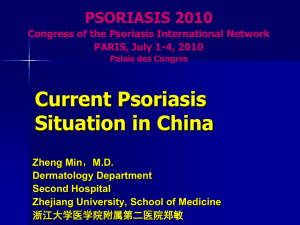Title: Single-blind efficacy and safety study in mild
advertisement
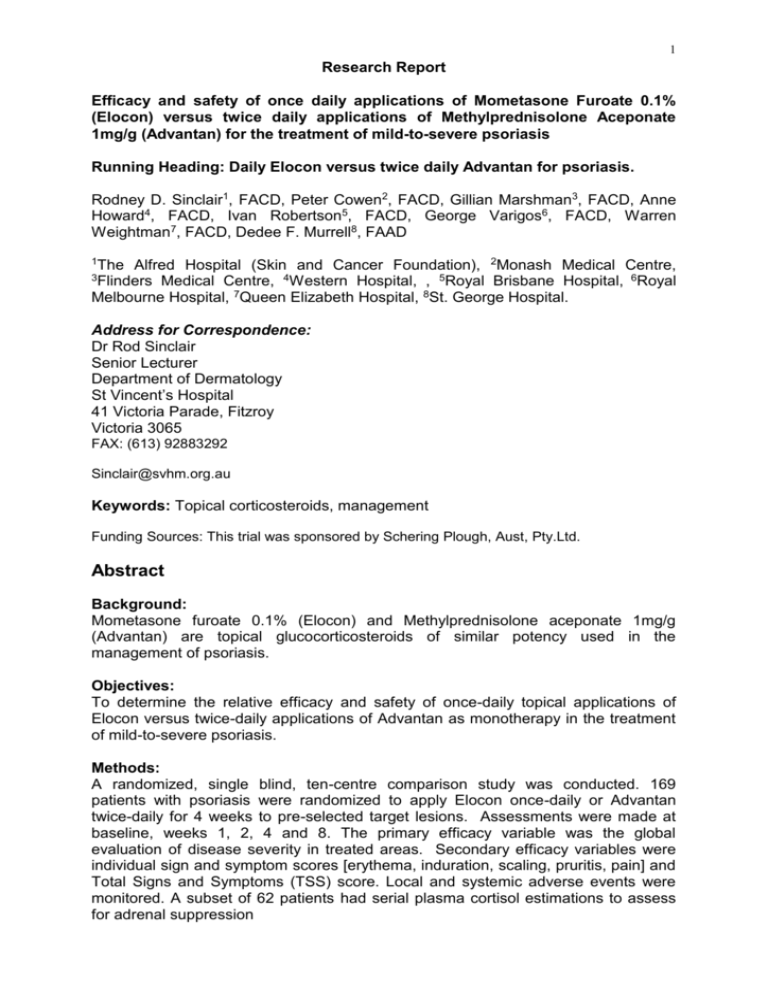
1 Research Report Efficacy and safety of once daily applications of Mometasone Furoate 0.1% (Elocon) versus twice daily applications of Methylprednisolone Aceponate 1mg/g (Advantan) for the treatment of mild-to-severe psoriasis Running Heading: Daily Elocon versus twice daily Advantan for psoriasis. Rodney D. Sinclair1, FACD, Peter Cowen2, FACD, Gillian Marshman3, FACD, Anne Howard4, FACD, Ivan Robertson5, FACD, George Varigos6, FACD, Warren Weightman7, FACD, Dedee F. Murrell8, FAAD 1The Alfred Hospital (Skin and Cancer Foundation), 2Monash Medical Centre, Medical Centre, 4Western Hospital, , 5Royal Brisbane Hospital, 6Royal Melbourne Hospital, 7Queen Elizabeth Hospital, 8St. George Hospital. 3Flinders Address for Correspondence: Dr Rod Sinclair Senior Lecturer Department of Dermatology St Vincent’s Hospital 41 Victoria Parade, Fitzroy Victoria 3065 FAX: (613) 92883292 Sinclair@svhm.org.au Keywords: Topical corticosteroids, management Funding Sources: This trial was sponsored by Schering Plough, Aust, Pty.Ltd. Abstract Background: Mometasone furoate 0.1% (Elocon) and Methylprednisolone aceponate 1mg/g (Advantan) are topical glucocorticosteroids of similar potency used in the management of psoriasis. Objectives: To determine the relative efficacy and safety of once-daily topical applications of Elocon versus twice-daily applications of Advantan as monotherapy in the treatment of mild-to-severe psoriasis. Methods: A randomized, single blind, ten-centre comparison study was conducted. 169 patients with psoriasis were randomized to apply Elocon once-daily or Advantan twice-daily for 4 weeks to pre-selected target lesions. Assessments were made at baseline, weeks 1, 2, 4 and 8. The primary efficacy variable was the global evaluation of disease severity in treated areas. Secondary efficacy variables were individual sign and symptom scores [erythema, induration, scaling, pruritis, pain] and Total Signs and Symptoms (TSS) score. Local and systemic adverse events were monitored. A subset of 62 patients had serial plasma cortisol estimations to assess for adrenal suppression 2 Results: Improvement in global evaluation at week 4 was observed in 92.8% of Elocon patients versus 84.7% of Advantan patients. . There was no significant difference in global evaluation scores between the treatment groups at weeks 4 or 8, however the scores were significantly different at week 2 in favour of Elocon (3.17 vs 3.49, p=0.03).. No patients had complete clearance of target lesions. TSS scores were reduced by 5.11 (65%) in the Elocon group and 4.38 (57.2%) at week 4, (P=0.04) The only significant difference between the 2 treatment groups in the individual signs and symptoms was for pain at week 8 (P=0.0003. Adverse events related to the study drug were uncommon and the only significant difference noted between the study drugs was a lower plasma cortisol level in the Elocon group at weeks 1 and 2 Conclusion: Elocon applied once daily is as effective as Advantan applied twice daily in the treatment of mild-to-severe psoriasis. Introduction Topical glucocorticoids are commonly used to in the management of psoriasis 1,2, however long-term use of moderately potent topical glucocorticoids is associated with local and systemic adverse events including skin atrophy and adrenal suppression3,4,5. Topical glucocorticosteroid formulations with greater efficacy and fewer adverse effects are desirable7. Topical cutaneous blanching is a surrogate marker of topical glucocorticosteroid efficacy6, and has been used to classify agents into 4 groups, with group 1 being the strongest and group 4 the weakest. Mometasone furoate and Methylprednisolone aceponate are both classified as group 2 agents7. For the treatment of chronic stable plaque psoriasis once daily application of Mometasone furoate and twice daily application of Methylprednisolone aceponate have been advocated, however the relative efficacy and safety of these two treatments is unknown. Methods and Materials Approval from institutional ethics review boards of the participating centres was obtained. 169 patients aged 18 or above with mild, moderate or severe stable or worsening psoriasis were recruited. Demographic data is shown in Table 1. Inclusion criteria were: (1) plaque psoriasis that has either been present for at least one year (or that has been previously treated with systemic corticosteroid therapy, not within six months prior to study entry), (2) a target lesion suitable for evaluation, and (3) a TSS disease severity score of at least 6 with the presence of three or more of: erythema, induration, scaling and pruritis. Patients were excluded if they were receiving concurrent systemic or topical anti-psoriasis therapy other than the application of keratolytic or tar shampoos to the scalp. Concomitant therapy for other conditions that was held constant during the study period was permitted. The trial was a randomized, single blind, ten-centre comparison study. Informed consent was obtained and eligible patients who fulfilled the enrollment criteria were assigned randomly to receive Mometasone furoate once daily (n=83) or Methylprednisolone aceponate twice daily (n=86) Treatment was continued for 4 weeks (28 days). A follow-up assessment was conducted in week 8. All enrolled patients were included in the safety analysis. A subset of 62 patients (28 from the 3 Mometasone furoate group and 34 from the Methylprednisolone aceponate group) had plasma cortisol monitoring. The primary efficacy variable was the change in overall global evaluation of psoriasis status for the treated lesions compared to baseline. The Total Signs and Symptoms (TSS) and individual sign and symptom (erythema, induration, pruritis, scaling, pain) scores in the target lesion were secondary efficacy variables. Target lesions were on the arms, trunk or legs. Evaluations were made by the investigator at baseline (week 0), weeks 1, 2, 4 and 8. Patients were instructed not to discuss any aspect of treatment applications with the investigator and the investigator did not query patients regarding this. After the initial (baseline) evaluation of the disease, each patient received either two tubes of Mometasone furoate or four tubes of Methylprednisolone aceponate each week. Dispensing was done by a third party. Used medication tubes were returned at each subsequent visit (weeks 1, 2 and 4), prior to further dispensing. Patient compliance with the protocol requirements was assessed by the third party who dispensed the medication at each return visit. Patients assigned to the Mometasone furoate group applied a thin layer of cream once daily to the specified area (target site and areas outside the target site as specified in the case report form). Patients in the Methylprednisolone aceponate group applied a thin layer of cream twice daily, with applications approximately 12 hours apart. For the visits at weeks 1, 2 and 4, no treatment was applied until after the evaluations. All adverse events were recorded in the subjects’ medical records and on the case report form. The onset and end dates, severity, pattern of event, effect on the administration of the treatments, and the relationship of the treatment to the development of adverse events was recorded for each adverse event. Systemic safety was determined through haematology, blood chemistry and urinalysis. Evaluations of plasma cortisol were obtained in a randomly pre-selected sub-group of 62 patients. Haematology measures included haemoglobin, haematocrit, RBC, WBC, neutrophils, lymphocytes, monocytes, eosinophils, basophils and platelets. Blood chemistry measures included sodium, potassium, chloride, urea, creatinine, uric acid, calcium, phosphorus, ALT, ALK, total bilirubin, cholesterol, total protein and albumin. Patients were also evaluated for telangiectasia within the target areas as a sign of skin atrophy. Efficacy was analyzed by comparing the two treatment groups with respect to the demographic variables and the entry level disease severity (this doesn't make sense - it implies a regression analysis which wasn't performed, use wording from Statistical Report). Gender, race, severity of disease and percent of body involvement were compared using the chi-squared statistic. Age was compared using the MannWhitney U statistic. The TSS score at entry was compared using a two-sample t test. Individual sign and symptom scores and the physician’s global evaluation of the change in disease status was compared using two sample t tests. Actual plasma cortisol levels and changes from pre-treatment baseline values were compared for the two treatment groups at each visit and at endpoint in a subgroup of patients in each treatment group through two sample t tests supplemented by non-parametric analyses. The number of patients in each treatment group with signs of adrenal suppression (plasma cortisol levels below normal range during treatment) were compared using the Fisher’s Exact Test. The level of statistical significance was set at =.05. 4 Results At week 4, 92.8% of Mometasone furoate patients and 84.7% of Methylprednisolone aceponate patients demonstrated improved disease sites, as assessed by mean global evaluation scores. There was no significant difference in global evaluation scores between the treatment groups at weeks 4 or 8, however the scores were significantly different at week 2 in favour of Elocon (3.17 vs 3.49, p=0.03) (Figure 1). The rate difference between the treatment groups at week 4 was 8.1% [95%CI: 1.4% to 17.5%]. Mean total signs and symptoms (TSS) scores were reduced by 4.38 (57.2%) in the Methylprednisolone aceponate group from a baseline mean of 7.68 to an end of drug therapy mean of 3.30 (Table 2, Figure 2). The Mometasone furoate group had a reduction of 5.11 (65.0%) from a baseline mean of 7.67 to an end of drug therapy mean of 2.56 (Figure 2). This difference between the 2 groups at week 4 in TSS was significant (p=0.04), (Table 2). The improvement in TSS scores was only partially retained four weeks post treatment. The 8 week mean for the Methylprednisolone aceponate group was 5.65 [ mean reduction of 2.02 (27.6%)] . The 8 week mean for the Mometasone furoate was 4.82 [mean reduction of 2.85 (35.2%)]. The difference between the 2 groups was not significant (Figure 2). For each of the individual signs and symptoms scores there was a trend toward a greater improvement in the Mometasone furoate group versus Methylprednisolone group (Table 3), however the only difference that was significant was the reduction in pain score at week 8 (p=0.0003). Both Mometasone furoate and Methylprednisolone aceponate were well tolerated. Fifty-eight patients in the Methylprednisolone aceponate group and forty-nine patients in the Mometasone furoate group experienced 81 and 83 adverse events, respectively. The most commonly reported adverse event in the Methylprednisolone aceponate group was psoriasis aggravated (36.05%), upper respiratory tract infection (6.98%), hypertension (4.65%) and pruritis (4.65%). The most commonly reported adverse events in the Mometasone furoate group was psoriasis aggravated (26.51%), headache (9.64%), influenza-like symptoms (7.23%) and arthralgia (4.82%). There were no significant differences between the 2 groups. (I can't find the support for this statement). Severity profiles for adverse events were similar in both groups. In the Methylprednisolone aceponate group 47% of adverse events were mild, 48% were considered moderate and 5% severe. In the Mometasone furoate group, 60% of adverse events were mild, 35% moderate and 5% severe. The severe adverse events in the Methylprednisolone aceponate group were eczema, psoriasis aggravated, paraesthesia and pruritis. In the Mometasone furoate group the severe adverse events were ataxia, psoriasis aggravated (X2) and fracture pathological. 88% of adverse events in the Methylprednisolone aceponate group were assessed as unrelated to the study drug compared to 98% in the Mometasone furoate group. The three adverse events in the Methylprednisolone aceponate group related to the study drug were psoriasis aggravated, contact dermatitis and paraesthesia. In the 5 Methylprednisolone aceponate group, 89% of adverse events did not effect drug administration compared to 97% in the Mometasone furoate group. The presence of adrenal suppression was determined by serial plasma cortisol concentrations in 62 patients. Adrenal suppression was defined as a plasma cortisol level of <200 nmol/L. Significant differences (P<0.05) occurred at week 1 and week 2 with plasma cortisol levels being lower in the Mometasone furoate compared to the Methylprednisolone aceponate group. Three patients in the Mometasone furoate group exhibited adrenal suppression at week 1, two patients in week 2 and one patient in week 8. One patient in the Methylprednisolone aceponate group had adrenal suppression at week 8. There were no significant differences in mean haematology, blood chemistry and urinalysis measures over time between the treatment groups. Discussion While mild to moderately potent topical corticosteroids have been shown to be effective in controlling localized psoriasis9, prolonged use is associated with adverse local and systemic effects which limits their clinical use 3,7. Topical corticosteroids that offer more favourable benefit-to-risk ratios are therefore desirable7. Mometasone furoate and Methylprednisolone aceponate are new generation topical corticosteroids of similar potency that both have a reduced incidence of skin atrophy, adrenal suppression, sensitization and cross reactions compared to other topical corticosteroids in their class9,10. In the treatment of chronic stable psoriasis, once daily treatment is recommended for Mometasone and twice daily treatment is recommended for Methylprednisolone aceponate. In this study, once daily applications of Mometasone furoate demonstrated comparable effectiveness in the management of mild-to-severe psoriasis compared to twice daily applications of Methylprednisolone aceponate. Both Mometasone furoate and Methylprednisolone aceponate were well tolerated. Mild treatment related adverse events occurred uncommonly in both groups, and did not cause the discontinuation of treatment. The incidence of adrenal suppression, as indicated by plasma cortisol levels, was low in both the Mometasone furoate and Methylprednisolone aceponate groups. Acknowledgments This study was sponsored by Schering-Plough Pty Limited. 6 References 1. Greaves MW, Weinstein GD. Treatment of psoriasis. New England Journal of Medicine 1995; 332:581-588. 2. Medansky RS, Cuffie CA, Tanner DJ. Mometasone furoate 0.1%-salicyclic acid 5% ointment twice daily versus fluocinonide 0.05% ointment twice daily in the management of patients and psoriasis. Clinical Therapeutics 1997; 19(4):701-9. 3. Kerscher MJ, Hart H, Korting HC, Stalleicken D. In vivo assessment of the atrophogenic potency of mometasone furoate, a newly developed chlorinated potent topical glucocorticoid as compared to other topical glucocorticoids old and new. International Journal of Clinical Pharmacology & Therapeutics 1995; 33(4):187-9. 4. Koivukangas V, Karvonen J, Risteli J, Oikarinen A. Topical mometasone furoate and betamethasone-17-valerate decrease collagen synthesis to a similar extent in human skin in vivo. British Journal of Dermatology 1995; 132(1):66-8. 5. Corazza M, Mantovani L, Marianini C et al. Contact sensitization to corticosteroids: increased risk in long term dermatoses. European Journal of Dermatology 2000; 10(7):533-5. 6. Cornell RC, Stoughton RB. Correlation of vasoconstrictor assay and clinical activity in psoriasis. Arch Dermatol 1985; 121:63-7. 7. Lebwohl M. A comparison of once-daily application of mometasone furoate 0.1% cream compared with twice-daily hydrocortisone valerate 0.2% cream in pediatric atopic dermatitis patients who failed to respond to hydrocorticosteroid: mometasone furoate study group. International Journal of Dermatology 1999; 38(8):604-6. 8. Hoffman K, Auer T, Stucker M et al. Comparison of skin atrophy and vasoconstriction due to mometasone furoate, methylprednisolone and hydrocortisone. Journal of the European Academy of Dermatology and Venereology 1998; 10(2):137-42. 9. Prakash A, Benfield P. Topical mometasone. A review of its pharmacological properties and therapeutic use in the treatment of dermatological disorders. Drugs 1998; 55(1):145-63. 10. Chong A, Sinclair R, Kelly J. Mometasone furoate. In: Therapeutic Drugs. (Dollery C, ed), 2nd edn. Edinburgh: Churchill Livingstone. 1999; 216-221.
